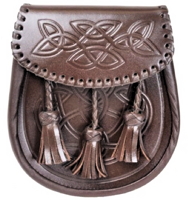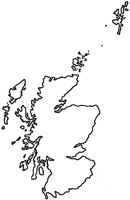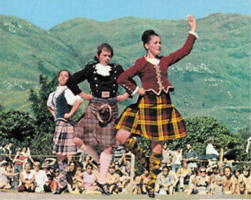
|
The Society of Folk Dance Historians (SFDH)
Who are Scottish Folk
[
Home |
About |
Encyclopedia | CLICK AN IMAGE TO ENLARGE |

|
 In this article the author will attempt to relate various aspects of the Royal Scottish Country Dance Society (RSCDS) experience to Scottish Folk Dance. The RSCDS is hereinafter known as the Society.
In this article the author will attempt to relate various aspects of the Royal Scottish Country Dance Society (RSCDS) experience to Scottish Folk Dance. The RSCDS is hereinafter known as the Society.
The folk who attend Scottish football matches chant, "We are the people" as they wave their blue and white scarfs. Folk to the Scot means "the people." Early Scotland was a mixture of Scots (Irish and Albannach), Picts (Piochdach), Welch (Cuimear), and Saxons (Sasunnah), with a sprinkling of Scandinavians, Netherlanders, and Normans who, by the 16th century, were divided by the Highland line between the Southeast that spoke a language calles Scots and the Northwest Gaelic speaking Celts (Gaidheil).
As a result of the work of the Society there is a new identifiable folk who might be called country dance folk. They are those who share a common dance tradition that is now international under the control of the Society and excludes the majority of Scottish folk at home and abroad.
The dances of the folk were commonly passed on by imitation and word of mouth in a tradition that continues to this day. Beginning in the 17th century, dances were collected and published but the majority of these were already dead before the Society and the English Folk Dance and Song Society (EFDSS), got started in their work. Currently dances are being reconstructed from old collections as few living sources currently remain. As a result, most pre-19th century dances are resurrections or reconstructions. Composition of new dances has never completely ceased but was not accepted or recognized by the Society until 1945.
Dancing in Scotland falls into six classes. The only surviving folk dances of Scotland are the various forms of Reels that as dances have survived in the Highlands and Islands or as figures in Contra dances and Quadrilles. Highland solo dances (flings, swords, etc.) have survived and are controlled by the Scottish Official Board Highland Dancing (c1953). The Scottish custom known as the Ceilidh (as in Potlach, Sobranja, or Hoot) has survived both with and without dancing (usually as a tourist spectator sport).
 There is a viable class system in Britain, sometimes called the "Country Set" that may be recognized by a style of Country Dance in Scotland. A derogatory term for this group is a "Yawh" which comes from the educated accent from south of the border. (It is felt that a "Yawh" comes somewhere between a preppie and a yuppie in the United States.) Their dances are usually formal, full Highland dress for the men and Tartan sashes for the women. Most wear heeled shoes. The repertoire is the same as for the Ceilidh dances with the addition of "The Duke and Duchess of Edinburgh" and "The Reel of the Fifty-First Division." Their styling is recognizable because of the substitution of Schottische for the Strathspey and the Walk or traveling Pas-de-Bas for the skip change of step in fast time.
There is a viable class system in Britain, sometimes called the "Country Set" that may be recognized by a style of Country Dance in Scotland. A derogatory term for this group is a "Yawh" which comes from the educated accent from south of the border. (It is felt that a "Yawh" comes somewhere between a preppie and a yuppie in the United States.) Their dances are usually formal, full Highland dress for the men and Tartan sashes for the women. Most wear heeled shoes. The repertoire is the same as for the Ceilidh dances with the addition of "The Duke and Duchess of Edinburgh" and "The Reel of the Fifty-First Division." Their styling is recognizable because of the substitution of Schottische for the Strathspey and the Walk or traveling Pas-de-Bas for the skip change of step in fast time.
Scottish Country Dancing was invented sometime between 1923 and 1930. Proof of this is found in the Society's publications starting from the first meeting in 1923 where the purpose of the Society was to preserve country dances as danced in Scotland where the 1930s constitution refers to Scottish Country Dancing.
Before the creation of the RSCDS, of which Jean Milligan was only one of many cofounders, there was no recognizable border between the Contra dances of Scotland and England. In fact, Mrs. Stewart of Fasnacloich, the founder, was admittedly influenced by the work of Cecil Sharp. Jean Milligan received her physical education training in England under a Swedish teacher. This author's earliest references to Jean Milligan is in a newspaper article concerning the 1912 Beltane Society Festival. While the program has "Flowers of Edinburgh" and "Blue Bonnets" (EFDSS versions), Jean Milligan appears later doing Morris Dancing.
The Society books one (1924) to six (1928) dances collected in the field. From book seven (1938), however, the entries are primarily revivals of dances of which there was no living memory. From book thirteen (1945), that contains the first modern composed dance onward, there is a mixture of living and revived dance. Currently the Society's books, now numbering thirty three (1985), are either entirely revived and edited "traditional" dances or those by modern choreographers.
Politics has had an important role to plan in how the Society controls the evolution of Scottish country dancing under its auspices today. By 1945, death and attrition left Jean Milligan the sole living and active member from the first 1923 meeting and it is now that she is referred to as THE cofounder. It is also interesting to note that two of the six oldest branches, Edinburgh (1924) and Dundee (1925) are not a part of the Milligan apostolic laying on of hands and their founders, and, as of last summer, were still alive.
With the Milligan years, the Society began to expand from twenty-two branches (including London and Manchester) to the present 148, mostly outside Scotland (Boston was the first non-British branch with Los Angeles and San Francisco tied for the third United States branches). Since the mid-20th century, the Society has thrived more abroad than at home. This was accentuated with the discontinuance of the requirement of the Society's preliminary teaching examination for all Scottish physical education teachers about the time Jean Milligan retired from Jordan Hill College of Physical Education.
It is in the nature of all folk arts to evolve. Even when written down, the majority of practitioners are functionally illiterate in their art. The Society's Publications Committee policy, however, is prescriptive.
There is no way in which evolution can ever be held back. The Society has had problems with their editorial philosophy of creating a "golden age" of how dances ought to be done, thus relegating earlier styles as primitive and later styles as decadent. As most Society dances were essentially dead, many deviant figures had to be devised to make poorly understood notes understandable. Many errors once published became engraved in stone, even though some cracks are still visible.
The problem is accentuated by the fact that the Society has quietly changed some dances without updating their copyrights. There are two ways of sequencing various editions of the Society's publications: checking the adverts in the back and the prices on the cover. Most footnotes in current Society publications should include the words "edited from . . ." or "inspired by . . ."
A summary of some of the anomalies are as follows. The "allemande" and the "pousette" as danced today did not exist before 1924. Two figures, "right and left" and "a chain of four," have been combined into one figure where the former did not involve the use of hands. Parallel figures were created when sources required mirror patterns. In some cases, two dances of the same name have been combined. And, in one case, the same dance was published twice with different names and tunes.
Although the tempo of Reels and Jigs has remained rather constant at mm116, the Strathspey has been slowed from mm168 to mm132 and is currently heading toward mm128 (a drop of 24 percent, which affects styling).
Society dances are danced out of context. The same dance published in Edinburgh and Cecil Sharp House (London) could be either Scottish or English respectively. When dances are removed from their native environment, some unusual mutations occur. A source refers to the man's raised Highland gesture as mimetic of a "stag prancing in the glen," while a more honest source refers to a "rutting stag." It is interesting to note that on some video clips, as the man lifts his hands in this gesture, the woman either opens her arms or lifts her skirt.
One must realize that the purposes of dancing have evolved along with the styling and figures. When one learns "foreign" dancing, one can only relate to one's own culture and body language. Village Ceilidh dances in Scotland are participated in by families of three to four generations and the dancing perpetuates the solidarity of the community while instilling social and cultural values in the younger generation (fathers waltzing with daughters, mothers holding infant sons, two brothers and a sister with her feet off the floor in a circle of six).
Today, people in the Society usually join as single people for social reasons and for many it stays at that level. For others, however, a lack of reinforcement elsewhere leads them to use the dance as a medium for their personal narcissism in exhibition groups or of personal political power in a dance organization. Because of today's fragmented and diverse life style, it is not possible to perpetuate dance forms from an older generation or another place without some structure. At the same time, organizations can produce pitfalls that are counterproductive to their stated goals. If an organization is too strong and rigid, it does not allow for the freedom of physical and emotional movement which is basic to dance in the first place. With too little organization, all the dances begin to look alike and the group loses its distinctive reason for existence. If an organization holds performance as a spectacle for its goal, it often produces a group of highly specialized dancers who are no longer members of the folk that they are supposed to represent. If the repertoire is too large, it can no longer be shared and there is a loss of social cohesion within the group.
Within the Society these problems exist. In Scotland there is a loss of ethnic participation in the dances of the Society while keeping some ethnic identification with the Scots as spectators.
DOCUMENTS
- Royal Scottish Dance Society, an organization.
- Scotland, a country.
- Scottish Country Dance, an article.
- Scottish Step Dance, an article.
Printed in Folk Dance Scene, April 1986.
This page © 2018 by Ron Houston.
Please do not copy any part of this page without including this copyright notice.
Please do not copy small portions out of context.
Please do not copy large portions without permission from Ron Houston.